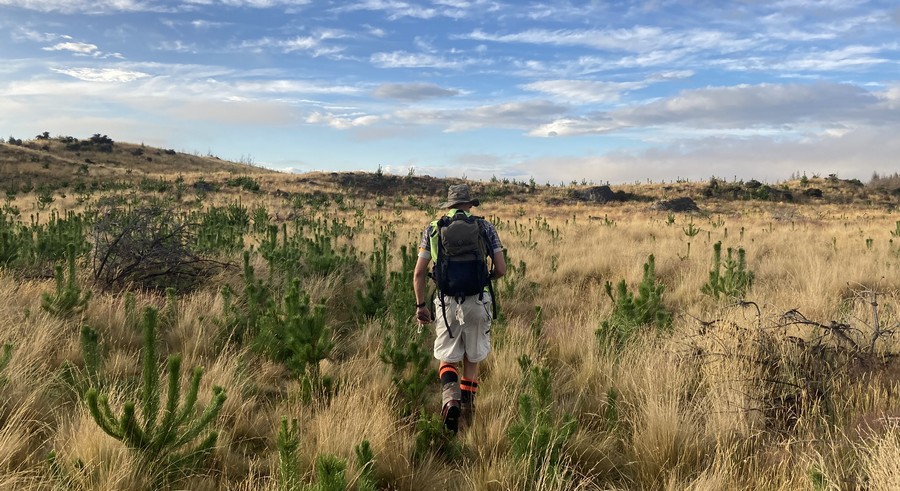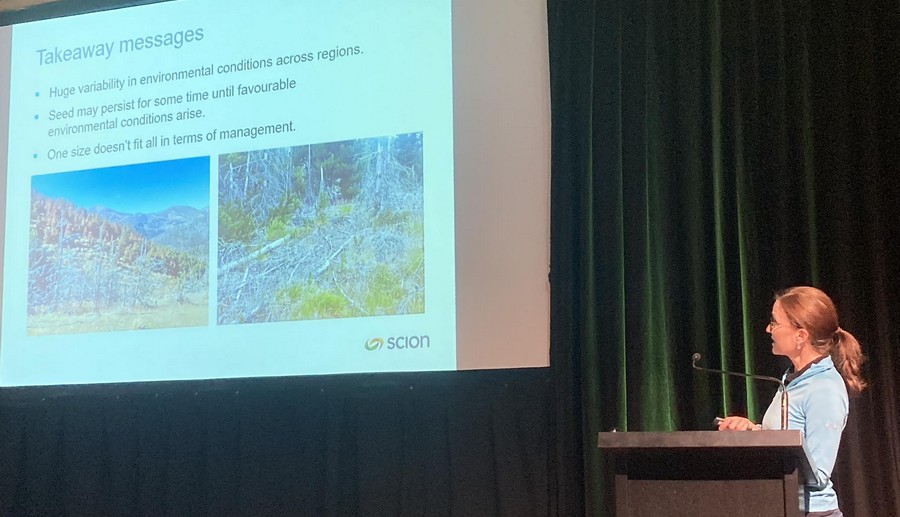Managing wilding pines
Wilding conifer issue
Wildings are a result of seedlings from introduced trees, mainly conifers, spreading and establishing in areas not designated for forestry. Wilding conifers are a serious economic and environmental problem. Existing populations of wilding conifers are being treated but cleared land is being re-invaded. For the National Wilding Conifer Control Programme to be successful, effective strategies to create long-term resistance to re-invasion on treated land are essential.
Scion has been researching wilding conifer ecology and management for over 20 years, supporting regional authorities and landowners in their efforts to control wildings.
Scion’s Dr Thomas Paul leads the MBIE Endeavour Programme: Vive La Résistance: Achieving long-term success in managing wilding conifer invasions.
Vive La Résistance
Vive la résistance (VLR) aims to achieve one important impact for New Zealand: to optimise wilding conifer management for long-term success by minimising re-invasion and maximising resilience to re-invasion of vulnerable landscapes.
Re-invasion processes differ significantly from those of initial invasion and a critical international knowledge gap exists on which major factors interact to drive conifer re-invasion. Building on the recent MBIE Endeavour Programme Winning against Wildings (2016-2021), Vive la résistance aims to disentangle the multiple drivers of re-invasion to overcome this gap and address the devastating problem of wilding conifer re-invasion.
Led by Scion, working with a wide range of internationally recognised invasion ecologists, the VLR programme will:
- quantify wilding re-invasion;
- understand the multiple factors, and their interactions, driving re-invasion;
- build ecosystem resistance to prevent re-invasion and improve management strategies to minimise re-invasion;
- co-develop practices with Ngati Rangitihi to prevent wilding re-invasion on Mt Tarawera and integrate these practices with outcomes from the other research areas.
This MBIE Endeavour funded five-year programme began in 2021, and since then excellent progress has been made on building our experimental platforms and relationships with key stakeholders, notably the National Wilding Conifer Control Programme (NWCCP; managed by Biosecurity NZ – a part of MPI), the wider wilding pine community (Wilding Pine Network; WPN), and other invested parties concerned with management of conifer invasions.

News and events
Scion scientists have shared their research in a new series of webinars run by the Wilding Pine Network (WPN). To watch recordings of the previous webinars or to stay informed about upcoming webinars, head over to the WPN website.
Seed predation results published
Wilding conifers are a major threat to New Zealand’s environment and economy. Understanding how these species invade and re-invade the landscape is critical to win the battle against these invasive trees.
As part of the complex puzzle of re-invasion Scion scientists are investigating how animals can affect wilding conifer populations by using their seed as a food source (seed predation), reducing the number of seeds in the environment. In May 2024, this seed predation research was published in the journal, Biological Invasions.
The wrong tree in the wrong place: the wilding pine problem
In 2023, Scion sponsored the annual Wilding Pines Conference, held in Queenstown. A team of Scion’s invasive plant ecologists went along to discuss the issue: Tom Carlin, Fiona Fields, Matt Scott, and Ryan Vorster piqued the interest of conference delegates by providing updates on some of the latest wilding pine research from the Scion-led Vive la résistance (VLR) programme. Presentations by Tom and Fiona highlighted some of the latest VLR insights and introduced some concerning dilemmas.
- Read more about the conference presentations over at the Wilding Pine Network

Research areas
Quantifying re-invasion
In this research area we capitalise on the unprecedented opportunity in tree re-invasion research to use the 860,000 hectares of land on which wildings have been managed since 2016 as a national-scale experimental dataset.
This unique dataset is being used to quantify for the first time the effects of large-scale control operations on wilding demographics along environmental gradients, using remote sensing analytics and proven ground-based methods to quantify control success and re-invasion rate. In doing so we are addressing an international knowledge gap by evaluating the in-situ effects of herbicide treatments on plant fecundity and seedbank viability.
Our national-scale sampling will provide new insights into re-invasion drivers and secondary invasion by other species, underpinning data needed to advance population dynamics modelling, and nationally significant information on control-treatment efficacy.
The first two years of research has been dominated by establishing our novel trial network and sampling of post-control wilding pine infestations along a time, space and invasion level gradient – a global first attempt to collect unbiased population data to understand re-invasion of tree invaders. In summer 2022-23 we sampled 189 field plots across five regions in New Zealand – the largest control operations over the past five years.
Preliminary analyses show that under the current control strategy eradication is difficult and re-invasion is occurring across the landscape. Quantifying cone traits of Pinus contorta has indicated that New Zealand possibly hosts a unique invasive conifer. This is an intra-specific hybrid between coastal and inland sub-species’ of P. contorta that produce larger cones and more viable seeds than the sub-species in their respective home ranges, traits that could contribute to the species’ increased invasiveness in New Zealand.
Related Links
- Wilding offenders: A new hybrid pine? (Scion Connections)
- Controlling wilding pines (Scion Connections)
- Vive la résistance – managing wilding conifer re-invasion (pdf)
- Wilding Pine Network (website)
- National Wilding Conifer Control Programme (website)
Publications
Peer reviewed publications
Carlin T.F., Scott, M.B., & Paul, T.S.H. (2025). Reproductive trait shift in Pinus contorta helps explain invasion success in Aotearoa New Zealand. New Zealand Journal of Ecology https://doi.org/10.20417/nzjecol.49.3584
Carlin, T.F., Paul, T.S.H., Dudenhoeffer, J.H. et al. The enemy of my enemy… Exotic mammals present biotic resistance against invasive alien conifers. Biol Invasions 26, 2647–2662 (2024). https://doi.org/10.1007/s10530-024-03336-z
Carlin, T.F., Vautrin, A.J., Paul, T.S.H., Rolando, C., Davidson, S.J., & Scott, M.B. (2024) Conifer samara structure diverges across the height of the tree crown. New Zealand Plant Protection https://doi.org/10.30843/nzpp.2024.77.11779
Klinger, S., Camarretta, N., Pearse, G.D., Steer, B.S.C and Paul, T (2024). Detection of wilding pines with Sentinel-2 and WorldView-3 satellite data. New Zealand Journal of Forestry, 69(1) 2024, pp 17 - 24 https://nzif.org.nz/nzif-journal/publications/article/23353
Rolando, C., Fields, F., Scott, M.B, Paul, T.S.H, Sapsford, S. (2024) Impacts of herbicides used for control of invasive Pinus contorta on the potential for reinvasion and germination of restoration species https://doi.org/10.1017/inp.2024.30
Rolando, C.A., Richardson, B., Schou, W., Somchit, C., Paul, T.S.H. and Scott, M.B. (2025), Optimising aerial herbicide treatment for control of dense conifer infestations: a New Zealand case study. Pest Manag Sci, 81: 2144-2154. https://doi.org/10.1002/ps.8612
Rolando CA, Scott MB, Baillie BR, Dean F, Todoroki CL, Paul TSH (2023). Persistence of triclopyr, dicamba and picloram in the environment following aerial spraying for control of dense pine invasion. Invasive Plant Science and Management. DOI: https://doi.org/10.1017/inp.2023.20
Rossignaud L, Hulme PE (2023). Native vegetation structure, landscape features, and climate shape non-native plant richness and cover in New Zealand native shrublands. Diversity and Distributions, 00, 1– 12. DOI: https://doi.org/10.1111/ddi.13713
Giora M, Hulme PE, Richardson DM, Pysek P (2023). Why are invasive plants so successful? Annual Review of Plant Biology, 74 DOI: https://doi.org/10.1146/annurev-arplant-070522-071021
Chyrva I, Jermy M, Strand T, Richardson B (2023). Evaluation of the pattern of spray released from a moving multicopter. Pest Management Science. 79, 4, p. 1483-1499, 17 p DOI: https://doi.org/10.1002/ps7320
Sprague R, Hulme PE, Nuñez MA, Peltzer DA (2022). How to link people, government, and science in effective, largescale invasive alien species control. Frontiers in Environmental Science. 10:970763 DOI: https://doi.org/10.3389/fenvs.2022.970763
Dickie IA, Sprague R, Peltzer DA, Green J, Orwin K, Sapsford S (2022). Applying ecological research to improve long-term outcomes of wilding conifer management. New Zealand Journal of Ecology 46(2):3475. DOI: https://dx.doi.org/10.20417/nzjecol.46.23
Rolando CA, Richardson B, Paul TSH, Somchit C (2021). Refining tree size and dose-response functions for control of invasive Pinus contorta. Invasive Plant Science and Management 14(2): 115–125. DOI: https://doi.org/10.1017/inp.2021.7
Richardson B, Rolando CA, Hewitt A, Kimberley M (2020). Meeting droplet size specifications for aerial herbicide application to control wilding conifers. New Zealand Plant Protection 73: 13–23. DOI: https://doi.org/10.30843/nzpp.2020.73.11712
Rolando CA, Gaskin RE, Horgan DB, Richardson B (2020). Effect of dose and adjuvant on uptake of triclopyr and dicamba into Pinus contorta. Plant–Environment Interactions 1(1): 57–66. DOI: https://doi.org/10.1002/pei3.10012
Conference proceedings
Patton (2023). LES-based work on seed dispersal over 2D vs 3D forested hills. 35th Conference on Agricultural and Forest Meteorology. Minneapolis, USA.
Arndt (2023). How do plant communities respond following the removal of a landscape invader? 4th International Congress on Biological Invasions, Christchurch, New Zealand.
Lynch, Jermy, Paul (2023). The response of wilding pines seeds to wind perturbation. 11th Fluids in New Zealand Workshop, Wellington, New Zealand.
Scott, Zhang (2023). War on Wildings: Continuing Flow Transport Model Development. eResearch NZ 2023 Conference.
Lynch, Kabaliuk, Paul, Jermy (2022). Relaxation of wind-perturbed pine seeds to stable autorotation, 23rd Australasian Fluid Mechanics Conference, Sydney, Australia.
Carlin, Wakelin, Garrett, Paul, Scott, Smaill, Addison, (2022). Wilding conifers in a warming world: potential problems with persistent pines. New Zealand Ecological Society Conference, Dunedin, New Zealand.
Carlin, Godsoe, Hulme (2022). Pre-adaptation to antipodean climates allows invasive weeds to thrive in Aotearoa. New Zealand Ecological Society Conference, Dunedin, New Zealand.
